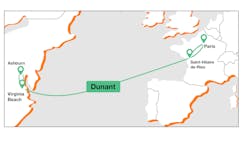Nokia and Orange set a record with an 800Gbps transmission trial on a 6,600 km Dunant live network to prepare for soaring traffic on the strategic trans-Atlantic route.
The trial used Nokia’s 6th-generation super-coherent Photonic Service Engine (PSE-6s), signaling the readiness of the Nokia 1830 family of optical transport platforms to carry next-gen 800GE IP services as global traffic demand soars.
For Orange, which conducted the trial under challenging real-world network conditions, it validated its ability to increase its existing optical network capacity to support end-to-end 400GE and next-generation 800GE services.
The Orange Dunant transatlantic subsea cable is a “hybrid” terrestrial and subsea connectivity solution for wholesale customers. Traffic can reach four points of presence in the Paris region, giving more connection options to wholesale customers.
Orange and Nokia demonstrated error-free performance during the trial at 800 Gbps over a 6,600 km link between the cable landing stations at Virginia Beach and St Hilaire de Riez, France, up from 400G in 2021. Additionally, the trial demonstrated 700 Gbps over a total link distance of 7,345km from Virginia Beach to Paris, vs 300G also in 2021.
Using 150GHz WDM spectrum channels, the terrestrial links consisted of nine spans of Orange’s existing fiber network through multiple cascaded reconfigurable optical add/drop multipliers (ROADMs).
What was important for Orange about the field trial is that it validated a planned upgrade of the Orange long-haul network using Nokia’s PSE-6s super coherent optics, demonstrating the ability to expand the capacity and spectral efficiency of existing subsea cable systems while reducing the number of coherent optics needed by 33% and lowering total power consumption compared with existing coherent optics.
Introducing the PSE-6 super coherent capabilities across the Nokia 1830 portfolio enables high-performance transport of high-speed services across long-haul, ultra-long haul and trans-oceanic networks spanning multiple thousands of kilometers.
“This trial demonstrates Orange’s commitment to supporting ever-greater network scale and new high-bandwidth services across our existing global network, which, combined with our subsea networks, truly powers global connectivity for our customers,” said Jean-Louis Le Roux, VP of international networks at Orange. “We are pleased to be the first operator to validate Nokia’s latest generation of super coherent optics in a subsea application as an important enabler to our constant need for network upgrades, with high spectral efficiency, sustainability, and operational deployment flexibility.”
For related articles, visit the Optical Tech Topic Center.
For more information on optical components and suppliers, visit the Lightwave Buyer’s Guide.
To stay abreast of optical communications technology, subscribe to Lightwave’s Enabling Technologies Newsletter.
Orange and Nokia demonstrated error-free performance during the trial at 800 Gbps over a 6,600 km link between the cable landing stations at Virginia Beach and St Hilaire de Riez, France, up from 400G in 2021. Additionally, the trial demonstrated 700 Gbps over a total link distance of 7,345km from Virginia Beach to Paris, vs 300G also in 2021.
Using 150GHz WDM spectrum channels, the terrestrial links consisted of nine spans of Orange’s existing fiber network through multiple cascaded reconfigurable optical add/drop multipliers (ROADMs).
What was important for Orange about the field trial is that it validated a planned upgrade of the Orange long-haul network using Nokia’s PSE-6s super coherent optics, demonstrating the ability to expand the capacity and spectral efficiency of existing subsea cable systems while reducing the number of coherent optics needed by 33% and lowering total power consumption compared with existing coherent optics.
Introducing the PSE-6 super coherent capabilities across the Nokia 1830 portfolio enables high-performance transport of high-speed services across long-haul, ultra-long haul and trans-oceanic networks spanning multiple thousands of kilometers.
“This trial demonstrates Orange’s commitment to supporting ever-greater network scale and new high-bandwidth services across our existing global network, which, combined with our subsea networks, truly powers global connectivity for our customers,” said Jean-Louis Le Roux, VP of international networks at Orange. “We are pleased to be the first operator to validate Nokia’s latest generation of super coherent optics in a subsea application as an important enabler to our constant need for network upgrades, with high spectral efficiency, sustainability, and operational deployment flexibility.”
For related articles, visit the Optical Tech Topic Center.
For more information on optical components and suppliers, visit the Lightwave Buyer’s Guide.
To stay abreast of optical communications technology, subscribe to Lightwave’s Enabling Technologies Newsletter.
About the Author
Sean Buckley
Sean is responsible for establishing and executing the editorial strategy of Lightwave across its website, email newsletters, events, and other information products.


